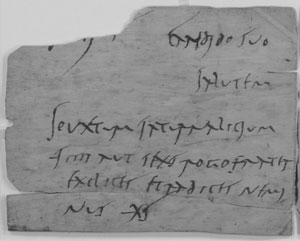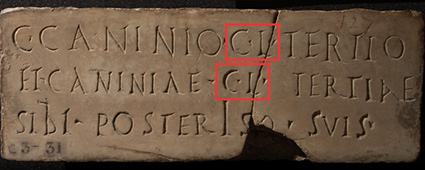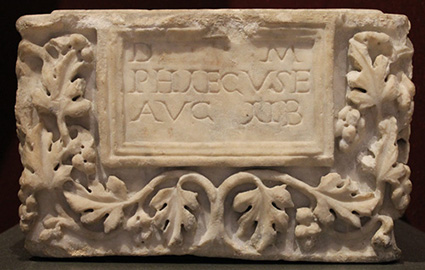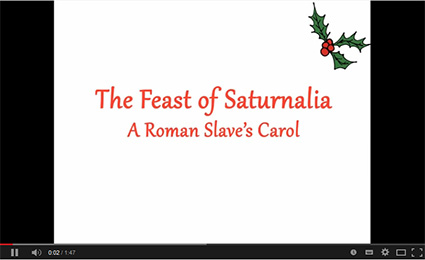A Roman Slave’s Carol
As the shortest day of the year drew near, the Romans crossed their fingers for a kind winter and people from all walks of life made a break in their usual routine to honour the harvest god, Saturn.
The festival of Saturnalia began on the 17th December and, at its longest, ran for a whole week until 23rd December. It was a time for communal worship, present-giving, over-eating, decorations, silly hats, party games, and goodwill towards men, especially those divided by the strict Roman rules governing social class.
In our new version of this familiar carol, we’ve been thinking about what Saturnalia must have been like for a Roman slave, and would he would have been looking forward to at this festive time of year. Here it is, sung by some of our friends from the Oxford Classics Faculty. All together now:
VII shouts of “Io!”
The traditional greeting at this time of year was “io, Saturnalia!” (pronounced “Eee-yo” or “Yo”). Romans used it both as a greeting and as a reply, in the same way that we might use “Merry Christmas”, but much louder. It was a cross between a sound of celebration and surprise. Io!
VI sprigs of holly
Many people think of holly and ivy as Christmas greenery, but they were both popular decorations for Saturnalia, used in wreaths and garlands. Holly had a special significance as the sacred plant of Saturn, and small sprigs were given to friends as tokens. Since holly berries are one of the few splashes of colour in the winter, it’s not surprising that they’ve been an unbroken fixture in winter festivals for thousands of years.
V figurines
On 23rd December, at the end of Saturnalia, the Roman celebrated Sigillaria. This was a day of gift-giving, exchanging expensive presents and small mementos. Even the Roman emperors joined in by giving gifts at Saturnalia (e.g. Augustus, Tiberius, and Vespasian).
Just like today, choosing the right present, and knowing how much to spend, was a tricky business. The 1st-century poet Martial teased his friend who had “re-gifted” him with all his Saturnalia presents, which were heavy, but cheap:
“At Saturnalia, Umber, you sent me all the presents that the five days had brought you: a dozen three-page writing-tablets and seven toothpicks; these were accompanied by a sponge, a napkin, a cup, four quarts of beans and Picenian olives, and a black flask of Spanish grape juice. And also came little Syrian figs and glazed prunes, and a jar heavy with the weight of Libyan figs. I reckon the presents, which carried by eight huge Syrians, were hardly worth thirty coins in total. How much easier it would have been, without any effort, for a boy to have brought me five pounds of silver!” (Martial. Epigrams VII. 53)
But the traditional gifts, which gave this day its name, were simple figurines made of wax, terracotta or wood (“Sigillaria” literally means “Day of little figures”).
What exactly the figurines were originally intended to represent is difficult to say, and it seems that even the Romans weren’t sure. In the fifth century AD, the writer Macrobius wrote a book on the Saturnalia, in which two characters seem to have different attitudes to Sigillaria figurines. One man argues that they had a religious meaning, and that the figures stood in for the sacrificial victims once demanded by the cult of Saturn (Saturnalia, 1.11.47-9). But the other man argues that they were completely secular, and nothing more than toys for children (Saturnalia, 1.11.1).
But as inexpensive gifts which could be bought in bulk from specialist sigillaria-makers (who set up stalls at this time of year), these are just the kind of thing a slave might have been given to mark the last day of the festival.
IV knucklebones
As another marker that “normal service” had been suspended during Saturnalia, slaves were allowed to gamble. In theory, this festive gambling was never a risk to anyone’s savings, since the traditional stakes were nuts (hence Martial’s memorable advice to Varro to “lose your Saturnalian nuts” in Epigrams V. 30). But open gambling was an important part of the noise and excitement that gave the Saturnalia its special atmosphere.
Even priests joined in with the celebrations. In his poem, Saturnalia, the 2nd-century poet Lucian has Cronos, a priest of Saturn say “During my week the serious is barred; no business allowed. Drinking, noise and games and dice, appointing of kings and feasting of slaves, singing naked, clapping of frenzied hands, an occasional ducking of corked faces in icy water—such are the functions over which I preside.” (Lucian, Saturnalia 1.2)
And even when the Roman Empire was officially Christian, the Saturnalian tradition of gambling was still so strongly associated with this time of year, that the famous Calendar of Philocalus (an illustrated Christian manuscript from AD 354), shows “December” throwing dice:
So why is our slave singing about knucklebones? The small distinctive bones, usually from a sheep’s foot, were used by both the Greeks and the Romans as dice. The Romans also used the six-sided dice that we still use today, but knucklebones were a traditional alternative. Although roughly rectangular, they had two rounded ends and so could only land on one of four sides. These sides were given the values of 1, 3, 4 and 6 and, just like hands in modern poker, different combinations of values were given special names. A present of knucklebones for our slaves meant that his master was happy for him to take time off and do something he usually wasn’t allowed to do.
III good meals
Saturnalia meant large-scale public feasts at the temples to Saturn, but there was also lots of eating and drinking at home, and slaves were allowed to join in. In one of the amazing handwritten letters from Vindolanda in Roman Britain, we find one slave writing to another about a food order for Saturnalia:

“Regarding the … for the Saturnalia, I ask you, brother, to see to them at a price of 4 or six asses and radishes to the value of not less than ½ denarius.” A letter from one slave to another, from Vindolanda near Hadrian’s Wall inv. 87.748
Dining was a central part of Saturnalia, and this was often combined with the seasonal tradition of role-reversal, with masters serving their slaves for a change. If a slave was lucky, his master would give him especially good food and drink, and he would be allowed to overindulge in both.
Macrobius seemed to think that it was the successful gathering in of all this food for the winter, with slaves and master working together for the good of the household (Saturnalia, 1.10.22), that was the origin of one of Saturnalia’s most characteristic traditions: time off for the unfree.
II pointy hats
The Romans were very particular about clothing. Certain colours, styles and accessories were often reserved for particular people. During Saturnalia, it was traditional for all men, regardless of status, to wear a pointed felt hat (called a pileus). This wasn’t just a party hat. It was the hat that a male slave began to wear after he had been freed, and had become a libertus (a freedman). Our slave is given two pilei: one for himself, and one to give back to his master. By allowing his slave to wear the pileus, our master was giving his slave a temporary promotion to freedom; and by offering to wear a pileus himself, the (freeborn) master was temporarily reducing himself to the level of the new freedman, a man at the bottom of the social ladder.
This tradition was a clever way of levelling the playing field between the two men, but in fact it was a fantasy. If our slave were ever freed, he would never really be on the same level as a freeborn man like his master. He would be labelled as an ex-slave for the rest of his life, and even if he became successful, wealthy and well-known (as many freedmen did), there would still be elements of Roman life that would be closed to him. Some people in the elite classes would never mix with freedmen. Pliny the Younger, for example, in Letters 7.29, calls successful freedmen “slime and filth”.
Roman naming conventions meant that a freedman took on part of his former master’s name, and in inscriptions we find the tell-tale letter L or LIB for “libertus” (for men) or “liberta” (for women) showing who they had originally belonged to. Even on the tombstones of people who had been free for years, building families and businesses on their own, the inscriptions often still acknowledge that they had once been slaves.

Tombstone for Gaius Caninius Tertius and Caninia Tertia, both of them recorded as C L, liberti of Gaius (Caius). Ashmolean ANChandler.3.31.
There was even a hierarchy among freedmen and freedwomen, depending on who their master had been. One inscription in the Ashmolean Museum belongs to a woman who had once been a slave in the emperor’s household:

Cremation urn of Phleguse, who was AUG LIB – “a freedwoman of the Emperor”. Ashmolean ANChandler.3.78, on display in the Randolph Gallery
… and a chance to pretend that I was free
As well as the pointy freedman-hats, the open gambling and the chance to eat the master’s food, there were other Saturnalia traditions which encouraged slaves and masters to step out of their usual roles.
In an ancient precursor to the “King” at the Feast of Fools (readers of Victor Hugo and Disney fans might remember this from The Hunchback of Notre Dame), Saturnalia allowed a member of a household, even one of the slaves, to be named the “King of Misrule”. In this reversal of the usual order, the male head of the family (the paterfamilias) had to do as he was told, and someone else was allowed to wear the master’s clothes, and make the decisions.
Saturnalia was an important festival for slaves, because it was the only time of the year when they really got to enjoy some time-off. And because Saturnalia was so strongly associated with freedom, Saturn became an important god for slaves. Martial’s Epigrams 3.29, describes a man named Zoilos dedicating his slave-chains to the god to mark his new freedom.
For many Roman citizens, Saturnalia was holiday to brighten up a dark winter. But for many Roman slaves, it was both a chance to step out of their present, and to dream about their future.
Io Saturnalia, everyone, and warm wishes from the AshLI team.





